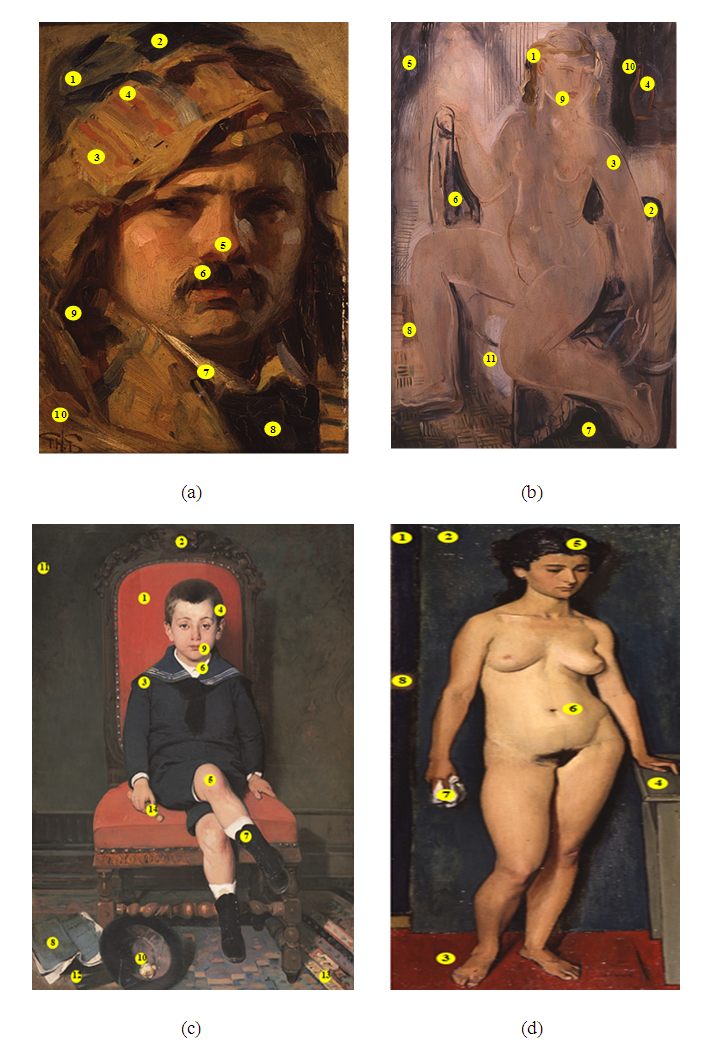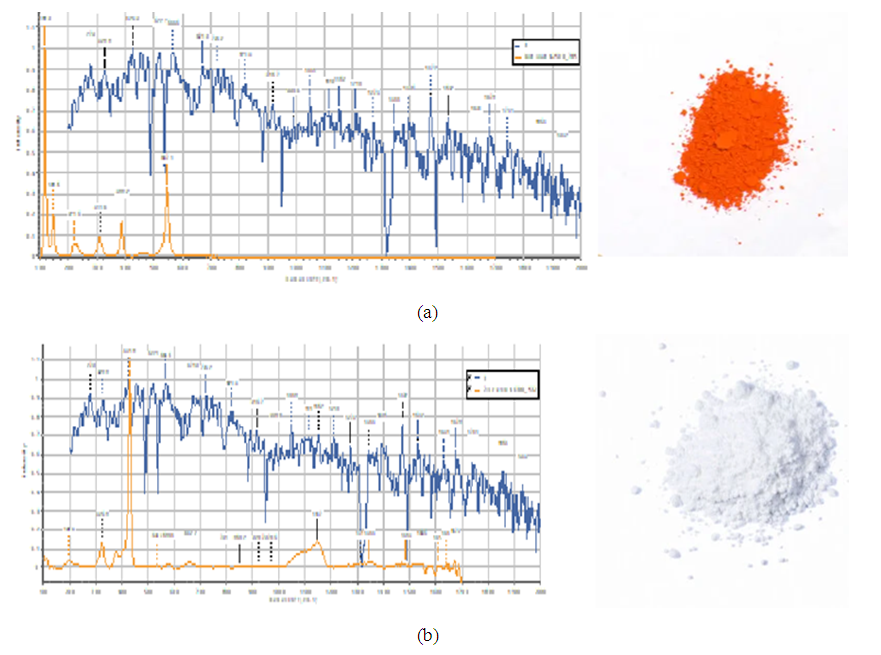-
Paper Information
- Paper Submission
-
Journal Information
- About This Journal
- Editorial Board
- Current Issue
- Archive
- Author Guidelines
- Contact Us
International Journal of Arts
p-ISSN: 2168-4995 e-ISSN: 2168-5002
2021; 11(1): 6-13
doi:10.5923/j.arts.20211101.02
Received: Nov. 2, 2021; Accepted: Nov. 19, 2021; Published: Nov. 26, 2021

Multi-scale Spectroscopic Characterization in Greek Painting: Three Eminent Painters are Evolving
Konstantina Romantzi, Theodore Ganetsos
University of West Attica, Industrial Design and Production Engineering Department, Athens, Greece
Correspondence to: Theodore Ganetsos, University of West Attica, Industrial Design and Production Engineering Department, Athens, Greece.
| Email: |  |
Copyright © 2021 The Author(s). Published by Scientific & Academic Publishing.
This work is licensed under the Creative Commons Attribution International License (CC BY).
http://creativecommons.org/licenses/by/4.0/

At the end of 19th century, after the eviction of King Otto, begins to flourish in Greece, the Greek modern painting. Portraying everyday tasks in urban centers, the countryside and portraiture, were the most popular thematic subjects. Greek painters start using oil paintings on canvas and in terms of style, influences from Europe are being adopted. Due to the close relations with Bavaria, the School of Munich is born, of which Nikephoros Lytras stands out as authentic representative. At the same time in Paris, Impressionism is born along with other new currents during the 20th century, apparent in the work of leading artistic personalities such as George Gounaropoulos and Yiannis Moralis, who belong to the Generation of Thirties. This study is focused on four paintings placed in the G. I. Katsigras Museum and executed by three different painters, namely Nikephoros Lytras, George Gounaropoulos and Yiannis Moralis. The study’s main purpose is to compare the pigments being used by the artists, in order to find out what changes occurred throughout the years, how were the painters affected by their stay abroad, whether the new artistic movements influenced their work and last but not least to reconstruct their color palette. That is why paint-ings from different decades were chosen. For this research two non-destructive methods were employed, XRF and Raman Spectroscopy among with optical microscopy. Several pigments were identified such as vermillion, titanium white, ultramarine natural, chrome green and red ochre.
Keywords: XRF Spectroscopy, Raman Spectroscopy, Pigments, G. I. Katsigras Museum, G. Gounaropoulos, Y. Moralis, N. Lytras
Cite this paper: Konstantina Romantzi, Theodore Ganetsos, Multi-scale Spectroscopic Characterization in Greek Painting: Three Eminent Painters are Evolving, International Journal of Arts, Vol. 11 No. 1, 2021, pp. 6-13. doi: 10.5923/j.arts.20211101.02.
Article Outline
1. Introduction
- The study concerns three famous Greek painters, who attend the School of fine Arts in Athens. They all traveled and went on with their studies and work in other Eu-ropean capitals, mingled with prominent personalities of the artistic field, gained worldwide fame and were honored for their contribution to Greek painting.G. Gounaropoulos (1889-1977), was a close friend of G.I. Katsigras, that explains the number of rare works the collector had in his possession. George Gounaropoulos was one of the early 20th century artists who introduced modern art in Greece. He is considered as one of the main representatives of the Generation of the ‘30s. Born in a Greek family in the town of Sozopolis on the Black Sea, George Gounaropoulos came to Greece with his parents and siblings in his early teens. His evident talent in painting was the only passport of the financially strained young migrant to the School of Fine Arts in Athens. Thanks to a grant by a Greek foundation, he was able to live in the ar-tistic capital of his time, Paris, and to study in the best independent art academies, namely l' Académie Julian and l’ Académie de la Grande Chaumière [1]. Under the in-fluence of the modern art movements and with his Greek cultural heritage deeply em-bedded in his artistic expression, Gounaropoulos developed his own personal artistic style, which evolved through the years and the creation of his oeuvre.The Municipal Art Gallery of Larissa, G. I. Katsigras Museum is housed in a mod-ern new building in Neapolis Quarter. G. I. Katsigras, a well-known doctor and signif-icant art collector announced in 1981, the donation of his collection to the Municipality of Larissa. Core of the Gallery is his collection, consisted of 700 paintings, which he had been collecting immensely from 1950 to about 1965. Fine examples of 19th century painting (Lytras, Iakovidis, Gyzis, Volonakis, Vikatos), as well as 20th century paint-ing (Gounaropoulos, Galanis, Parthenis, Regos), it also contains oil paintings, water-colors, drawings, and engravings. Furthermore, the Gallery exhibits the work of local artists and non-permanent collection are being held.Two of the artist’s paintings have been thoroughly studied. The first painting Self Portrait (Figure 1a) 1912 (oil on board, 27,5x17 cm) is one of the earliest works by Gounaropoulos. Its heavy, dark colour palette and the expressive gaze of the sitter are typical of the artist’s academic style, as he mastered it at the School of Fine Arts in Athens [2]. The representation of the artist in a turban, the pose, and the light on the left half of the face are reminiscent of Rembrandt’s Self-portrait at the easel 1660 in the Louvre. Interestingly, a reproduction of this particular Rembrandt self-portrait was always hung next to Gounaropoulos’s study table. Similarly, Gounaropoulos’s self-portrait was always hung next to Katsigra’s desk.The second painting Fair-haired nude 1924-25 (Figure 1b) (oil on canvas, 91x64 cm) is a transitional work that illustrates the development of the artist’s personal style. His palette becomes brighter and his colours very fluid, creating an impression of lightness. As a result, his sensuous, volumetric female figure becomes gradually trans-parent and ethereal, floating in the pictorial space as if defying gravity. This type of female representation will define the artist’s mature style and will evolve further over the next decades. [2]Nikephoros Lytras (1832-1904), was one of the leading representatives of the School of Munich. He is the father of modern Greek painting. The most important part of his work consisted of genre scenes, which he, in essence, introduced to Greek paint-ing and which contains scenes from the Greek provinces, the Greek family, and the world of the child. He is also considered to have been innovator in the sector of por-traiture, where his endeavor to penetrate the psychology of the figure being depicted can be readily seen. He was born in the Greek island Tinos and he studied painting at the School of fine Arts in Athens. In 1860 he left for Munich where first on a scholar-ship from the Greek government and then with the support of Baron Simon Sinas, he completed his studies at the Academy of Fine Arts, his principal teacher being Karl von Piloty. In 1876 he visited Paris along with his close friend Nikolaos Gyzis. [2,11]The painting being analyzed in this study is the Portrait of Constantine M. Mela 1879 (Figue 1c) (oil on canvas 117x83), one of the most important painting of Munici-pal Gallery of Larissa. The depicted little boy is originated from a known Athenian family, who owned the mansion at the Post Office Square. In 1881 the first private collection was held at the house of Vassilis Mela’s, it consisted of 170 artworks by Greek painters and sculptors in favor of the Red Cross. Lytras as an innovator in the sector of children’s’ portraiture, has depicted the small child on a red armchair. There are no similar full-length portraits of children with this conscious position, indicative of the social class of the bourgeoisie. Inthis painting Lytras combines elements from adult portraits with the color austerity and intensity of ethnographic scenes.Yiannis Moralis (1916-2009) was born in Arta, he attended the Sunday painting lectures at the Athens School of Fine Arts. In 1931 after successfully completing the entrance examinations, he enrolled in the preparatory section of the school and in 1936 he assured himself a scholarship from the Athens Academy to study mosaic abroad. Thus, the following year he left with his friend the painter Nikos Nikolaou for Rome, but he soon departed and settled in Paris. There he studied at the School of Fine Arts painting under Charles Guerin and wall painting under Ducos de l’Haille. In 1948 Moralis started his career as full professor at the preparatory division of the School of Fine Arts.Moralis also belongs to the representatives of the Generation of ‘30s. He had a de-finitive influence on the field of post-war art in Greece. With his work, he has achieved in painting the yoking of the classical and modern. Though interested in a variety of thematic categories, such as landscape and still life, his creative work, both in its real-istic and geometric stage, is first and foremost anthropocentric, with Eros and Thana-tos its axes.The painting Nude (Figure 1d) 1948 (oil on canvas 86x31), belongs to an artistic period, in which the painter starts depicting two or more figures in his paintings. Women usually naked or lightly dressed, who no longer “speak” with their expression or colors but with a restrained, latent movement which breaks the frontality of his previous works and exude lyrism, passion, joy or sorrow, recollection, and peace. A full body female naked figure in young age is depicted, frontal with her head turned to the right and the look lowered. Her posture reminisces the contrapposto of the ancient Greek statues, in which the standing human figure is poised such as the weight rests on the so-called engaged leg, freeing the other leg, which is bent at the knee. The back-ground is of dark tints, her black hair falls behind her shoulders, the body has been rendered rather realistically, while the painter’s palette that frames the figure is lim-ited in green, red and blue color.The scientific examination and comparative investigation of pigments is funda-mental for further understanding and analyzing of historic and artistic works, and particularly useful for conservators. Since there is no one technique allowing for posi-tive and unambiguous identification of every pigment, a combination of techniques is often required. The investigations were carried out using two spectroscopy methods in the X-ray range, X-ray fluorescence (XRF) and μ-Raman spectroscopy. These methods have been used for pigment identification with success in the past, with the first method being specific to the elements present in the sample, and Raman spectroscopy being specific to the compounds. The widespread use and number of different instruments that have been developed and employed for the application of XRF analysis illustrates well the value, advantages and usefulness of this analytical method in the field of art and archaeology. Development of portable XRF instrumentation expands the range of use of this technique to an even wider area, by allowing in situ measurements on objects regardless of their shape, size or place where they are stored and/or displayed [5,9–13].
2. Materials and Methods
- In this study only non-destructive methods were applied, in order to identify the pigments on the artists’ paintings and to reconstruct their color palette, as his work has only been analysed theoretically so far. The analytical techniques used were X-ray Flu-oresence along with Raman Spectroscopy and Optical Microscopy, which were per-formed in-situ. [6-8]To detect the chemical elements in percentages and in traces the portable Ther-moscientific X-MET-8000 Expert XRF analyzer was used, equipped with a 50KV mini W-Target X-Ray Tube and a Single Collimator of 6mm diameter. In order to acquis it the data, a built-in software was used, and measurements were saved, for further analysis with specialized software. Due to the nature of research a cross-check calibration was applied with pigments of known XRF spectrum, supplementary to the built-in shutter calibration. [3]. In total 70 measurements were carried out with XRF technique, and the colours studied were: Green, blue, yellow, red, pink, brown, black, and white.Regarding the Raman analysis measurements were taken at the same points so as to identify the chemical composition of each pigment, by using a portable Rock-Hound Delta Nu Raman Spectometer, equipped with a near-infrared 785nm laser source, ad-justed to 8 cm-1 resolution and a spectrum range of 200 cm-1 to 2000 cm-1 was used. To ensure the correct Raman shift measurements and operation, calibration tests were conducted using the specific palette of pigments Checker. Scientific software Spec-traGryph was used to analyze the spectra and then, identification of the chemical compositions was achieved through cross-referencing them to the international pig-ments databases, Clark (UCL) [5], Checker (Italy) [4].All measured Raman spectra, before the main process of pigment identification were subjected to a pre-processing procedure such as baseline correction, Savitzky - Golay smoothing and normalization [8].Finally, optical microscopy was conducted with the contribution of flashlight type LED black lights FL-100/200 with UV-A intensity and UV wavelength. To ensure the right operation at the required UV intensity, the microscope had been first checked and a photometer specially designed to measure the UV irradiance from 320-400 nm with a peak at 365 nm was chosen. We used optical microscopy in order to have a bet-ter understanding of the better understanding of the colour hue.
3. Results and Discussion
- In figures 1 (a-d) are shown with yellow dots all the sampling points for each col-our hue. Following is presented a table (Table 1) with all summarized results of XRF analysis and pigments identified by Raman spectroscopy. In figures 2-6 are shown representative Raman spectrums for different colours along with reference spectrums. The analysis of all paintings with a portable XRF revealed elements which turned up to be rather helpful in order to identify the specific pigments and reach to fruitful conclusions.
 | Table 1. This table represents the experimental data using XER and Raman Spectroscopy |
 | Figure 2. Experimental Raman data (blue) in comparison with Raman data from Pigments checker data base (yellow) - Titanium White |
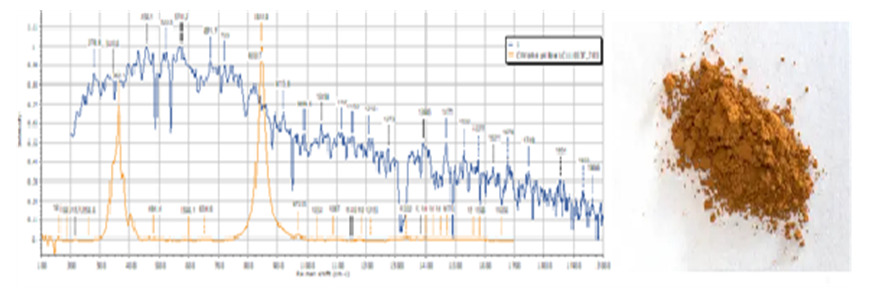 | Figure 3. Experimental Raman data (blue) in comparison with Raman data from Pigments checker data base (yellow) – Yellow Ochre |
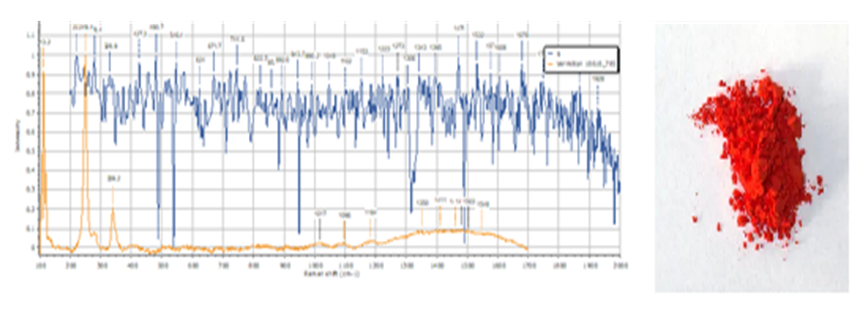 | Figure 4. Experimental Raman data (blue) in comparison with Raman data from Pigments checker data base (yellow) – Vermillion |
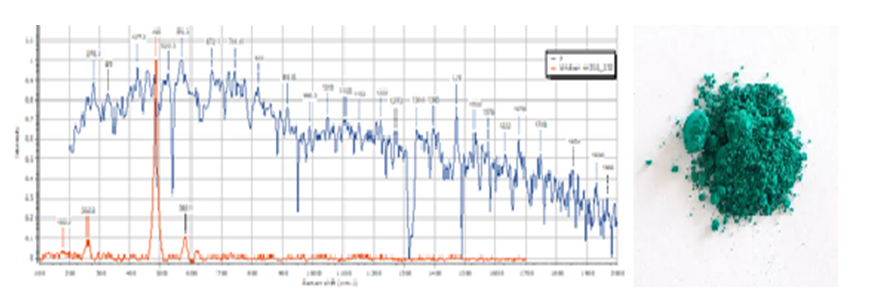 | Figure 5. Experimental Raman data (blue) in comparison with Raman data from Pigments checker data base (yellow) - Viridian |
4. Conclusions
- In conclusion, this study aimed at the pigment identification of the four paintings. At the same time the painters’colour palette was revealed, following the trends of time and the movements they all represented. It’s rather impressing to notice the different pigments they chose in order to depict the same colour. Summarizing the results G. Gounaropoulos, N.Lytras and Y. Moralis have used for blue colour Ultramarine, for white either Titanium White or Lead White and Zinc White. Yellow Ochre was used for yellow. Cadmium Red, Red Ochre and Vermilion for red colours and orange, Car-bon Black and Ivory Black for black, whereas for green colour malachite, green cobalt and chrome green were used. Brown colour was consisted of Burnt Sienna and Raw Umber and pink colour appeared as the most complicated as different combinations of pigments were identified. Lead White and Red Lead were used, or Red Ochre and Zinc White and on some occasions Titanium White and Cadmium Red. As the work of G. Gounaropoulos has not been examined so far through non-destructive techniques, this study could be a useful tool for the art historians in order to better understand the painter’s art. Furthermore, fruitful conclusions could be conducted regarding the Greek painting. The reproduction of the painters’ colorful palette can be used to give answers looked for, by art historians and collectors interested in cultural heritage.
ACKNOWLEDGEMENTS
- The Director of G. I. Katsigras Museum I. Deligianni is specially thanked for her permission and generous help during the in-situ experimental measurements.This is a part of PhD Thesis of K.R. The University of West Attica is also thanked for the funding to this PhD without this valuable support this research would not have been carried out.
 Abstract
Abstract Reference
Reference Full-Text PDF
Full-Text PDF Full-text HTML
Full-text HTML